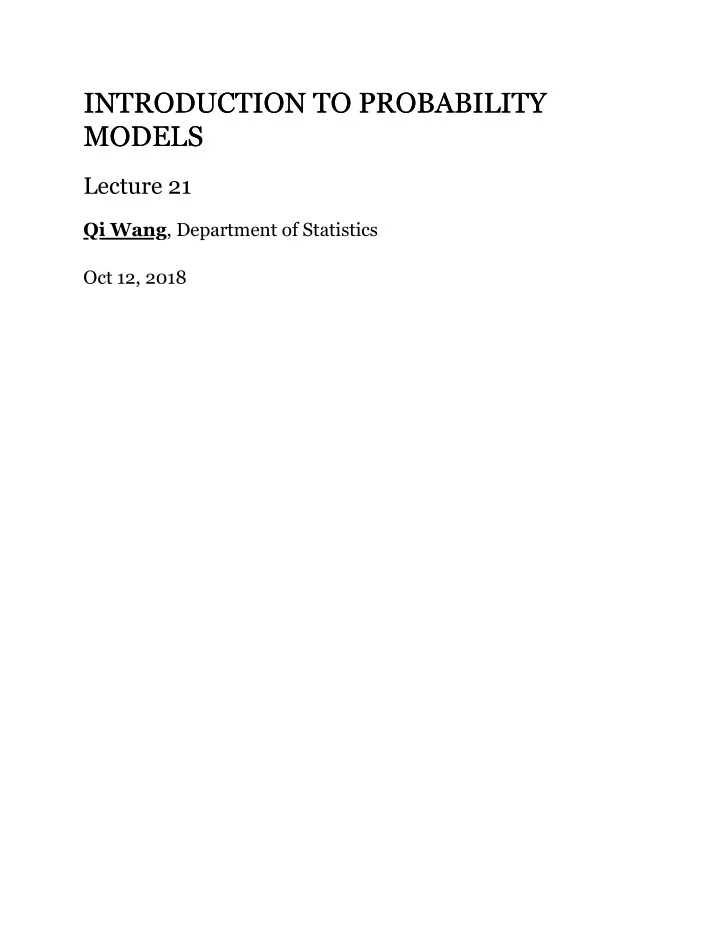

INTRODUCTION TO PROBABILITY INTRODUCTION TO PROBABILITY MODELS MODELS Lecture 21 Qi Wang , Department of Statistics Oct 12, 2018
DISCRETE RANDOM VARIABLES DISCRETE RANDOM VARIABLES Bernoulli Binomial Hypergeometric Poisson Geometric Negative Binomial
BERNOULLI DISTRIBUTION BERNOULLI DISTRIBUTION The definition of : the success of some event on a single trial. Support: Parameter: p PMF: Expected Value: Variance:
BINOMIAL DISTRIBUTION BINOMIAL DISTRIBUTION The definition of : the total number of successes in a sequence of n independent Bernoulli experiments, with a success rate p Support: Parameter: n, p PMF: Expected Value: Variance:
HYPERGEOMETRIC DISTRIBUTION HYPERGEOMETRIC DISTRIBUTION The definition of : the number of success in trail without replacement from a finite population of size N that contains exactly M objects with that feature. Support: or Parameters: Population size Number of possible successes Number of trials PMF: Expected Value: Variance:
POISSON DISTRIBUTION POISSON DISTRIBUTION The definition of : the number of success per , and can be time, length, space unit and so on Support: Parameters: , the average success rate per PMF: Expected Value: Variance:
GEOMETRIC DISTRIBUTION GEOMETRIC DISTRIBUTION The definition of : the number of trials to get the first success Support: , NOTE: NO ZERO! Parameter: , the probability of success in one trial PMF: Expected Value: Variance:
NEGATIVE BINOMIAL DISTRIBUTION NEGATIVE BINOMIAL DISTRIBUTION or The definition of : the number of trials to get the success Support: Parameter: : the probability of success in one trial : success of interest PMF: Expected Value: Variance:
EXAMPLE 1 EXAMPLE 1 In a jar there are 200,000,000 coins, 5,000,000 of which are quarters. You select 50 coins from the jar randomly and without replacement. Let X be the number of quarters in your sample. 1. What is the distribution of X? 2. Find the probability that X is 2 3. Is there an approximate distribution for X, why or why not? If there is, call the approximation and find as well
EXAMPLE 2 EXAMPLE 2 The wonderful candy shop, Albanese Candy Outlet, makes chocolate chip cookies as part of their production line. Chocolate chips in the cookies are randomly and independently distributed with an average of 12 chocolate chips per cookie. You and 9 of your friends decide to make a trip to Albanese Candy Outlet. Each of you buys one chocolate chip cookie.
1. What is the probability that your cookie contains between 10 and 15 chocolate chips inclusive? 2. What is the probability that 5 or 6 people in your group have cookies with between 10 and 15 chocolate chips inclusive? 3. While examining your cookies (one-by-one), what is the probability that it takes at least 4 cookies to find the first one with between 10 and 15 chocolate chips inclusive? 4. While examining your cookies (one-by-one), what is the probability that it takes at least 4 cookies to find the first one with 12 or 13 chocolate chips? 5. Suppose you and your 9 friends were to go repeatedly to Albanese Candy Outlet. What is the probability that it takes until your sixth trip so that 5 or 6 people in your group have 12 or 13 chocolate chips in their cookie?
EXAMPLE 3 EXAMPLE 3 Name the distribution, parameter(s) and support X is the number of 5's in ten rolls of a fair die. A baseball starting lineup consists of nine players, three of which are outfielders. A random sample of three players is taken from a baseball starting lineup. Let X be the number of outfielders in the sample. X is the number of Hearts in a five-card poker hand dealt from a standard 52 card deck. Let us repeatedly deal out five-card poker hands (replacing the cards after each hand is dealt). Let X be the deal number of the first time in which we get a flush Let us repeatedly deal out five-card poker hands (replacing the cards after each hand is dealt). Let X be tahe deal number of the eighth time in which we get a a straight(allow the A-5 straight). A player wins a game if he/she rolls at least one 6 in four rolls of a fair die. Let X be the outcome (win or lose) of this game.
Recommend
More recommend